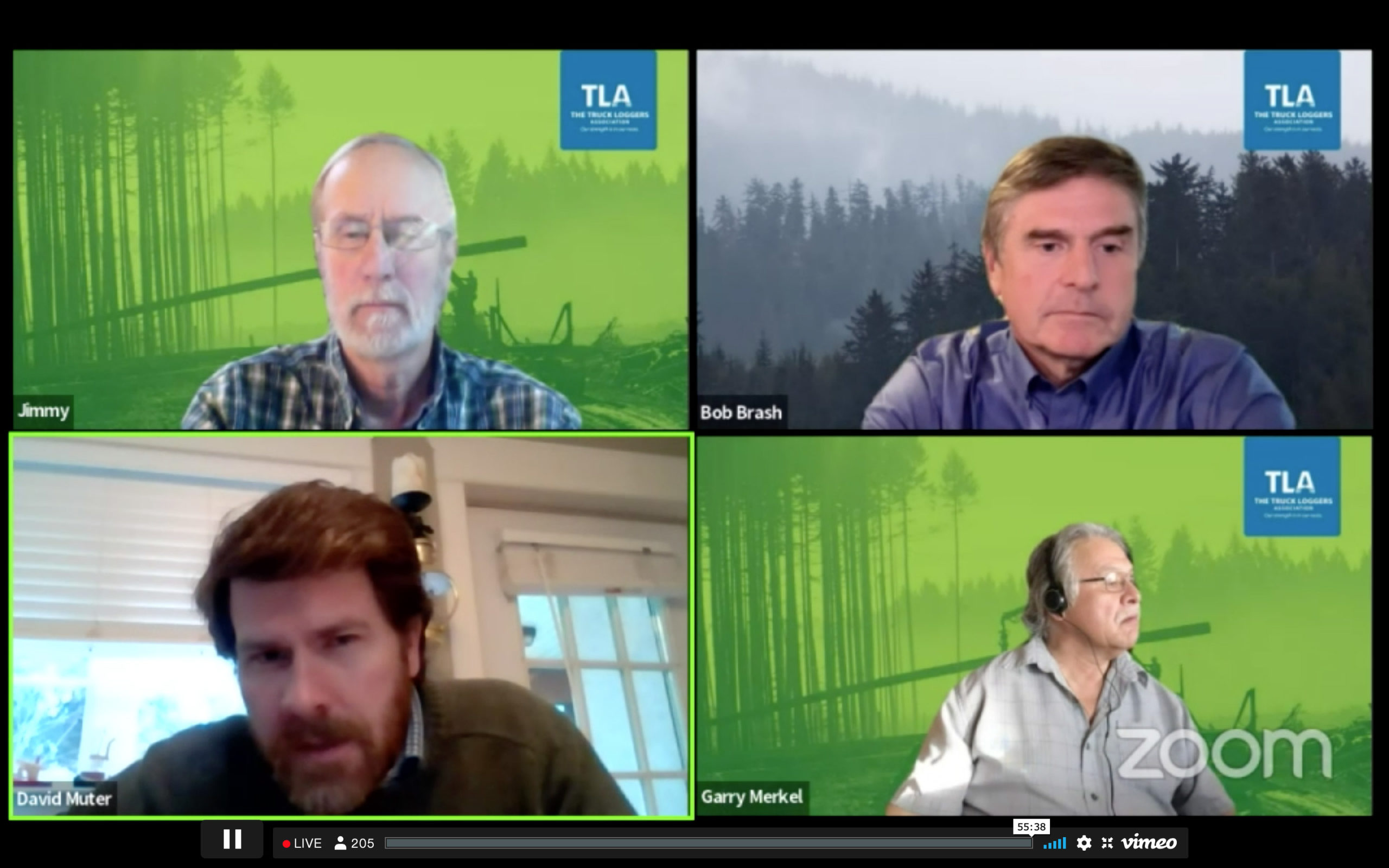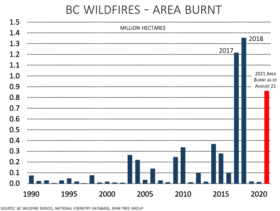
Bob Brash, Charlene Higgins, Susan Yurkovich and Melissa Sanderson
Delving deeper into the merits of the specifics, was the second TLA session on perspectives related to Modernizing Forest Policy in BC. Melissa Sanderson, ADM, Forest Policy and Indigenous Relations, BC Ministry of Forests, described the government’s vision and context—which is that the current policy framework is inadequate to address today’s challenges. According to Sanderson, the Intentions Paper was “greatly informed by engagements that have taken place in the past, notwithstanding the challenge of overlapping crises [covid, fires and floods], and that the engagement will be ongoing”.
Charlene Higgins, CEO of the BC First Nations Forestry Council, described what she’s been hearing from First Nations related to the modernization policies as “one of frustration… and that frustration is growing”. According to Higgins, this is because the polices were developed with no First Nations involvement. …Given government’s alignment with many of the First Nations Forestry Strategy goals, Higgins called the effort a “missed opportunity”. As such, she is seeking a full reset on the engagement process. Higgins concluded by saying, “the public wants a different approach to the use of BC’s forests, with real collaboration with First Nations regarding the use and management of forest land and resources.” And “First Nations involvement in the sector as full partners is the new paradigm that will create the climate for investment needed to support a thriving forest sector.”
Susan Yurkovich, President and CEO of the BC Council of Forest Industries, noted “the importance of this conversation because of breadth and depth the industry has on the economic and social fabric of the province.” From industry’s perspective, the modernization of BC’s forest policy must start with a fact-based, balanced, and inclusive approach (agreed set of facts and then look at balancing the values); an inclusive group of people (meaning everyone is at the table); have Indigenous Nations as full partners (a say and meaningful revenue sharing); and champion BC’s low-carbon forest products as part of the climate solution.”
“But”, says Yurkovich, “predictable access to fibre at a reasonable cost is the key for all participants, regardless of size. …We need policy choices that are going to create predictability to encourage innovation and reinvestment.” …”There are a lot of challenges but also a lot of opportunities. BC has great people, great fibre, and the expertise, knowhow and technology to capitalize on the opportunity to be the preferred supplier of low-carbon, sustainable management forest products that will fight climate change. But we have to get it right, and we can’t get it right if we aren’t all working together.”
 Kansas City Southern will begin talks with CN Rail, as the slugfest between Canadian archrivals (CN and CP) gets ugly. In other Business news: new home sales jump again in the US, Gorman’s Nick Arkle on why lumber is so expensive; Brock Mulligan on the related boon for Alberta’s forest industry; the Wall Street Journal on why this market ride is more robust than past booms; and Cees de Jager on the Softwood Lumber Board 2020 ROI. Companies in the news include: Paper Excellence, Kandola Forest Products, and Biewer Lumber.
Kansas City Southern will begin talks with CN Rail, as the slugfest between Canadian archrivals (CN and CP) gets ugly. In other Business news: new home sales jump again in the US, Gorman’s Nick Arkle on why lumber is so expensive; Brock Mulligan on the related boon for Alberta’s forest industry; the Wall Street Journal on why this market ride is more robust than past booms; and Cees de Jager on the Softwood Lumber Board 2020 ROI. Companies in the news include: Paper Excellence, Kandola Forest Products, and Biewer Lumber. Assuming all the announced transactions are completed. …The top five companies are led by #1 West Fraser (which is also the largest OSB producer), followed closely by #2 Canfor (including its Swedish mills), #3 Weyerhaeuser, #4 Interfor (with its recent acquisition of EACOM as well as four G-P mills), and #5 Sierra-Pacific (with its acquisition of Seneca). Each of these behemoth companies have more than 5 million m3 (3 billion bf) of lumber capacity. Stora Enso at #6… with mills throughout nine countries in Europe as well as Russia. Moving up quickly in the ranks… is #7 binderholz headquartered in Austria with the strategic acquisitions of the two ex-Klausner sawmills in the US South and BSW’s seven sawmill sites in the UK, one in Latvia and seven other production sites in the UK.
Assuming all the announced transactions are completed. …The top five companies are led by #1 West Fraser (which is also the largest OSB producer), followed closely by #2 Canfor (including its Swedish mills), #3 Weyerhaeuser, #4 Interfor (with its recent acquisition of EACOM as well as four G-P mills), and #5 Sierra-Pacific (with its acquisition of Seneca). Each of these behemoth companies have more than 5 million m3 (3 billion bf) of lumber capacity. Stora Enso at #6… with mills throughout nine countries in Europe as well as Russia. Moving up quickly in the ranks… is #7 binderholz headquartered in Austria with the strategic acquisitions of the two ex-Klausner sawmills in the US South and BSW’s seven sawmill sites in the UK, one in Latvia and seven other production sites in the UK.



 With the wild price run that has been in effect since about June of 2020, it is starting to become more obvious that the North American wood products supply chain is completely strained. …While a temporary shortage of lumber, OSB and plywood has occurred, it is more a function of short-term constraints [which] have impacted the supply side during this strong demand cycle, so hence the runaway commodity wood products prices. The simple math is this… If demand grows by more than about 2.5 billion bf this year and in 2022, then there will be a potential gap and that will create more ongoing price volatility. The only region in North America that has added any significant new lumber capacity in North America is the US South.
With the wild price run that has been in effect since about June of 2020, it is starting to become more obvious that the North American wood products supply chain is completely strained. …While a temporary shortage of lumber, OSB and plywood has occurred, it is more a function of short-term constraints [which] have impacted the supply side during this strong demand cycle, so hence the runaway commodity wood products prices. The simple math is this… If demand grows by more than about 2.5 billion bf this year and in 2022, then there will be a potential gap and that will create more ongoing price volatility. The only region in North America that has added any significant new lumber capacity in North America is the US South. 

 Kicking off Day 2 of the TLA’s panels on the BC government’s efforts to modernize forest policy was David Muter, ADM, Resource Stewardship Division, BC Ministry of Forests. …According to Muter, “putting a temporary pause in place on priority old growth areas provides the time and space to better understand what old growth we have left and how best to manage it.” Although the Technical Committee operated independent of government, Muter noted that “Ministry experts worked closely with the committee so as to understand the basis of their technical work and its credibility.” With respect to how the government’s commitment to First Nations is progressing, Muter said that, “some Nations feel confident in their current management regime (usually because of their deep partnerships with industry) and said they may not need deferrals. Some Nations said they need more time and others see the need for deferrals and want to proceed.”
Kicking off Day 2 of the TLA’s panels on the BC government’s efforts to modernize forest policy was David Muter, ADM, Resource Stewardship Division, BC Ministry of Forests. …According to Muter, “putting a temporary pause in place on priority old growth areas provides the time and space to better understand what old growth we have left and how best to manage it.” Although the Technical Committee operated independent of government, Muter noted that “Ministry experts worked closely with the committee so as to understand the basis of their technical work and its credibility.” With respect to how the government’s commitment to First Nations is progressing, Muter said that, “some Nations feel confident in their current management regime (usually because of their deep partnerships with industry) and said they may not need deferrals. Some Nations said they need more time and others see the need for deferrals and want to proceed.”
 Next up was RBC analyst Paul Quinn, who titled his talk, BC – What Went Wrong and What Needs to Happen Now. As for what went wrong, Quinn says it’s “those policy changes that add even more costs to BC’s new status as North America’s high cost producer”. In effect, Quinn described the government’s efforts to modernize the forest sector as “the problem”. “Capital and investment are risk adverse and money flows away from uncertainty or it requires a premium return to offset the increased risk”, according to Quinn. “Unfortunately, the BC industry is producing below average returns while demonstrating a high and rising risk profile. BC has moved from the lowest cost jurisdiction in North America in 2010 to the highest cost in 2021, and recent policy changes will exacerbate the situation. Simply put, BC is becoming uninvestable”.
Next up was RBC analyst Paul Quinn, who titled his talk, BC – What Went Wrong and What Needs to Happen Now. As for what went wrong, Quinn says it’s “those policy changes that add even more costs to BC’s new status as North America’s high cost producer”. In effect, Quinn described the government’s efforts to modernize the forest sector as “the problem”. “Capital and investment are risk adverse and money flows away from uncertainty or it requires a premium return to offset the increased risk”, according to Quinn. “Unfortunately, the BC industry is producing below average returns while demonstrating a high and rising risk profile. BC has moved from the lowest cost jurisdiction in North America in 2010 to the highest cost in 2021, and recent policy changes will exacerbate the situation. Simply put, BC is becoming uninvestable”. Can anyone remember a more tumultuous time in BC forestry? Changes are afoot but the question is whether these changes are built on the solid foundation needed for success. The truth is, probably not. Let’s start with the old-growth issue and government’s decisions to “start” deferring substantial areas from harvest forever. …The truth is, BC has world leading levels of outright protection of land and forests, truly sustainable harvesting, stringent regulatory requirements, and the highest proportion of independently certified forests in the world. …The truth is about 30 per cent of BC’s old-growth forests can grow the “big” trees most of the public associates with their definition of old growth. …The truth is, BC’s value-added sector heavily depends on continued old-growth harvesting.
Can anyone remember a more tumultuous time in BC forestry? Changes are afoot but the question is whether these changes are built on the solid foundation needed for success. The truth is, probably not. Let’s start with the old-growth issue and government’s decisions to “start” deferring substantial areas from harvest forever. …The truth is, BC has world leading levels of outright protection of land and forests, truly sustainable harvesting, stringent regulatory requirements, and the highest proportion of independently certified forests in the world. …The truth is about 30 per cent of BC’s old-growth forests can grow the “big” trees most of the public associates with their definition of old growth. …The truth is, BC’s value-added sector heavily depends on continued old-growth harvesting. The BC forest sector is being overwhelmed by a series of major changes to forest policy. …In the span of less than 30 days, the NDP government has made six announcements that will massively reshape the sector. Taken individually, some of these changes notionally are not necessarily bad ideas. …Unfortunately, delivering these changes as a package all at once will be very problematic. …Primary manufacturers are a strategic component to the rest of the industry, and if they shut down there will be huge holes that will not be filled for years, or maybe never. While rebalancing the sector as a concept has its positives… the series of major policy changes has cast a pale of toxicity onto the industry. It has reaffirmed institutional investors’ view of BC under the NDP as un- investable. Boards of the major companies are now likely directing their operations to reduce unnecessary expenditures and cancel any upgrades. Already, and sadly, contractors are seeing their amount of work diminish.
The BC forest sector is being overwhelmed by a series of major changes to forest policy. …In the span of less than 30 days, the NDP government has made six announcements that will massively reshape the sector. Taken individually, some of these changes notionally are not necessarily bad ideas. …Unfortunately, delivering these changes as a package all at once will be very problematic. …Primary manufacturers are a strategic component to the rest of the industry, and if they shut down there will be huge holes that will not be filled for years, or maybe never. While rebalancing the sector as a concept has its positives… the series of major policy changes has cast a pale of toxicity onto the industry. It has reaffirmed institutional investors’ view of BC under the NDP as un- investable. Boards of the major companies are now likely directing their operations to reduce unnecessary expenditures and cancel any upgrades. Already, and sadly, contractors are seeing their amount of work diminish.


 In the second week of September something happened which has not occurred for a very long time with any Canadian provincial government – the Saskatchewan government announced new timber allocations. …All four companies receiving these timber allocations have capacity investments of almost $1 billion. …Saskatchewan’s announcements make me want to call this province the “US South of Canada” because I cannot recall in the last decade when else such a large active expansion of the Canadian industry has taken place.
In the second week of September something happened which has not occurred for a very long time with any Canadian provincial government – the Saskatchewan government announced new timber allocations. …All four companies receiving these timber allocations have capacity investments of almost $1 billion. …Saskatchewan’s announcements make me want to call this province the “US South of Canada” because I cannot recall in the last decade when else such a large active expansion of the Canadian industry has taken place.

 Balanced solutions to B.C.’s old-growth forests protection that best serves all British Columbians is possible — but it seems out of reach. For example, the provincial government’s recently announced Old Growth Technical Advisory Panel that will dictate government’s decision-making on logging deferrals is very troubling. Not because of its intent, but for the blatant unbalanced representation of its members. This committee — absent of any forest-sector professionals, forestry-dependent communities or First Nations leadership — will recommend and lobby for new areas needed to be protected without any understanding of the consequences of their opinions. …But dig a bit deeper and you’ll find the composition of its members dominated by Sierra Club affiliates and other individuals … vocally against any continued old-growth harvesting.
Balanced solutions to B.C.’s old-growth forests protection that best serves all British Columbians is possible — but it seems out of reach. For example, the provincial government’s recently announced Old Growth Technical Advisory Panel that will dictate government’s decision-making on logging deferrals is very troubling. Not because of its intent, but for the blatant unbalanced representation of its members. This committee — absent of any forest-sector professionals, forestry-dependent communities or First Nations leadership — will recommend and lobby for new areas needed to be protected without any understanding of the consequences of their opinions. …But dig a bit deeper and you’ll find the composition of its members dominated by Sierra Club affiliates and other individuals … vocally against any continued old-growth harvesting.

